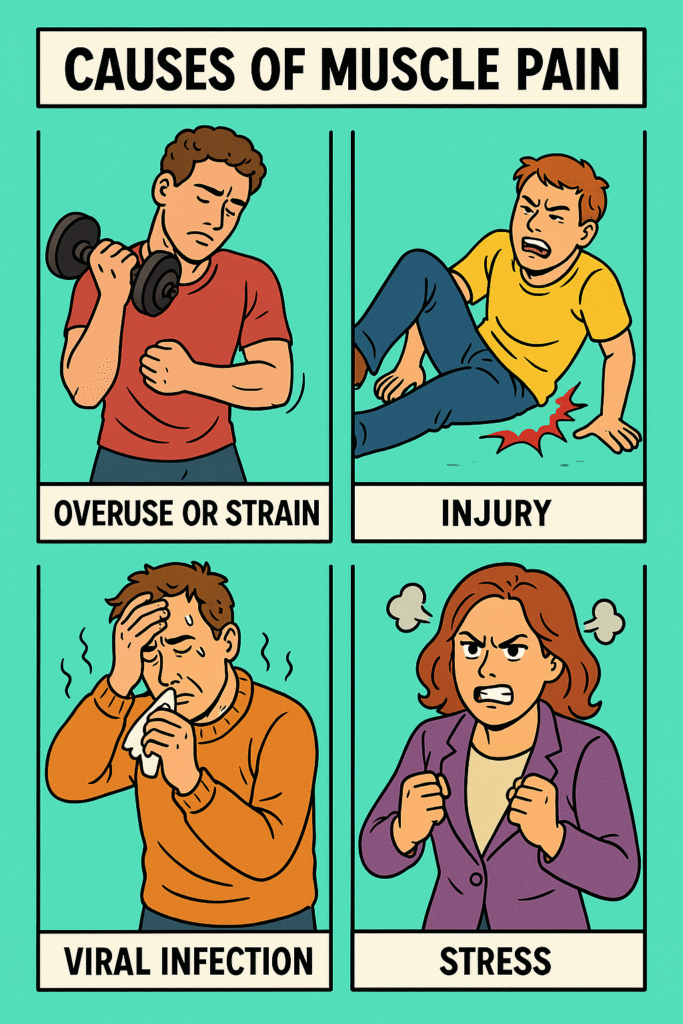Muscle pain—also called myalgia—is something we’ve all experienced. Whether it’s from lifting something heavy, a bad night’s sleep, or a viral infection, muscle pain can range from mildly annoying to deeply uncomfortable. But what causes it? When should you worry? And what can you do to feel better?
Let’s break it down in plain, everyday language.
What Is Muscle Pain?
Muscle pain is discomfort felt in the muscles—anywhere in the body. It can be sharp or dull, constant or occasional, and either localised (in one area) or widespread. It’s one of the most common symptoms people report to doctors.
Some quick facts:
- Most cases are due to overuse or minor injury.
- Up to 80% of adults will experience muscle pain at some point.
- It’s often harmless, but in rare cases, it can signal something more serious.
How Does It Happen?
Think of your muscles like rubber bands. They stretch and contract to help you move. But when you:
- Overuse them
- Strain them
- Or expose them to infection or toxins
…those “rubber bands” can become inflamed or damaged.
Your immune system then rushes to the area, causing inflammation—which creates that soreness, stiffness, or throbbing ache. If the pain is from an infection or a chronic illness, the muscle fibres themselves may not be injured, but chemical signals from your immune system still irritate the area.
It’s your body’s way of saying, “Hey, take it easy!”
What Causes Muscle Pain?
There are many possible causes. Some are very common; others are rare or linked to other conditions.
Main causes include:
- Overuse or Strain (≈ 60%)
Happens after intense exercise, heavy lifting, or repetitive motion. - Injury or Trauma (≈ 15%)
Like a fall, pulled muscle, or sprain. - Viral Illnesses (≈ 10%)
Flu, COVID-19, and even the common cold often cause muscle aches. - Stress and Tension (≈ 5%)
Emotional stress can cause tight muscles, especially in the neck, shoulders, and back. - Chronic Conditions (≈ 5%)
Conditions like fibromyalgia, chronic fatigue syndrome, and polymyalgia rheumatica cause widespread muscle pain. - Medications and Toxins (≈ 2%)
Statins (cholesterol-lowering drugs), chemotherapy, or even electrolyte imbalance can lead to muscle pain.

Who’s at Risk?
Muscle pain can happen to anyone—but certain people are more likely to feel it.
Here are the top risk factors:
- Athletes or physically active people – from overuse or minor injuries
- Elderly individuals – muscles weaken with age
- People with poor posture or sedentary lifestyle
- Those with viral infections
- Individuals on certain medications (e.g., statins)
- People with autoimmune or chronic inflammatory conditions
Other Symptoms to Look Out For
Muscle pain doesn’t always come alone. Depending on the cause, you might also experience:
Common symptoms:
- Muscle stiffness
- Weakness
- Fatigue
- Tenderness when touching the area
If the condition gets worse or is more serious:
- Fever (may suggest infection)
- Swelling or redness
- Dark-coloured urine (possible muscle breakdown)
- Joint pain or rashes (may suggest autoimmune causes)
- Pain that doesn’t go away after a week or two
When in doubt, always check with your doctor.
Tests to Identify the Cause
If the muscle pain is mild and clearly from overuse, you might not need any tests. But if it’s ongoing or has other symptoms, doctors may use:
- Physical examination – checking the site of pain, movement, and tenderness
- Blood tests – to check for infection, inflammation, or muscle damage (e.g., CPK levels)
- MRI or Ultrasound – to detect tears, inflammation, or deeper problems
- Electromyography (EMG) – to evaluate muscle and nerve function
The gold standard test depends on the suspected cause. For example, in suspected rhabdomyolysis (muscle breakdown), creatine kinase (CK) blood levels are crucial.
Treatment for Muscle Pain
Mild to moderate muscle pain usually gets better on its own with rest. But here’s a more detailed look at your options:
1. First-line treatment (Gold Standard):
- R.I.C.E. method:
- Rest the muscle
- Ice the area (20 minutes at a time)
- Compression with a bandage if swollen
- Elevation to reduce swelling
2. Medications:
- Pain relievers: Paracetamol or ibuprofen
- Muscle relaxants (in more severe cases)
- Topical creams: like menthol-based rubs
3. Alternative options:
- Massage therapy
- Heat packs (after 48 hours)
- Stretching and light movement
- Physical therapy, especially for chronic or post-injury cases
4. For specific causes:
- Viral: rest and hydration
- Fibromyalgia: multidisciplinary approach with medication, exercise, and therapy
- Medication-related: change or stop the drug (under doctor’s advice)
When to see a doctor:
- If the pain lasts more than a week
- If it keeps coming back
- If it’s associated with fever, swelling, weakness, or dark urine
Final Thoughts
Muscle pain is common—but that doesn’t mean it should be ignored. Whether you’ve overdone it at the gym, picked up a bug, or your medication is the culprit, muscle aches are your body’s way of asking for attention.
Listen to it.
Take time to rest, recover, and seek help if things don’t feel right.
References
- “Muscle Pain (Myalgia)” – Mayo Clinic, 2023. https://www.mayoclinic.org/symptoms/muscle-pain/basics/definition/sym-20050866
- “Muscle Pain” – MedlinePlus, U.S. National Library of Medicine, 2022. https://medlineplus.gov/musclepain.html
- “Myalgia: Causes, Symptoms and Treatment” – Cleveland Clinic, 2023. https://my.clevelandclinic.org/health/symptoms/17606-myalgia
- “Fibromyalgia: Symptoms and Causes” – NHS UK, 2024. https://www.nhs.uk/conditions/fibromyalgia/
